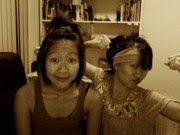I am a member of a Singapore photography forum called ClubSnap. It is here that I inhabit an online identity for myself. Here, not everyone knows how the other looks like. Neither do they get to know much about the person except for the photos they have taken. Unlike the very popular Friendster, avatars in this forum are rarely those which display pictures of the user and the information page of each member is scarce. Identity plays a key role in virtual communities. (Donath, 1996) It is in this forum, I have established an identity for myself not as a student or a 23 year old female, but as a photographer.

In this forum, it is not so much who you are that matters, but the kind of pictures you take, the number of entries you post and the information you give or are given based on photography. Who you really are, and how you look never really matters. These are the main basis for establishing reputation in this forum. To set a reputation in this forum means being able to accomplish at least two of the three mentioned.
I participate most often in a section of the forum called “Photo A Day.” In this section, members are encouraged to post pictures a day or whenever possible for other members viewing. It is in this very section that I believe I have set a reputation for myself. Why would I say so? Well, in this section, how many times your thread has been viewed is shown at the side of each entry. With this display at the side, members can take a look at whose thread, or pictures have been viewed the most. The more views, the better people think you are. The better they think you are, the more likely they are to view your thread. The more positive comments you get about your photograph, the more people would look up to your photography skills.
According to the Identity Theft and Assumption Deterrence Act (2003)[ITADA] amended the U.S. Code, s. 1028 - "Fraud related to activity in connection with identification documents, authentication features, and information". The Code now makes possession of any "means of identification" to "knowingly transfer, possess, or use without lawful authority" a federal crime, alongside unlawful possession of identification documents. (Wikipedia, 2007)
As identified in this act, the “transfer, possess, or use without lawful authortiy” can be considered as identity theft. It is because of this that has made posting pictures online has its worries. With little evidence that the taken picture is yours, there is a possibility that your work could be stolen by someone else. With programs such as Photoshop made available for the public for the use of editing images, pictures stolen could be made to look like its ones own when it is not. Photoshop intimidates me. No, it is not because it is hard to use, but because of its capabilities. Most often that not, people are advised to “stamp” or personalize logos onto their pictures before posting online. However, these logos or stamps can easily be blurred, stamped, and erased away with the use of programs such as Photoshop and passed off elsewhere as works of their own. The picture below demonstrates how one can "stamp" their picture with words and a signature at the bottom.

As much as this may sound more like a copyright issue, rather than an identity theft, one must come to understand that in the photography world, the photographs taken by a photographer does not simply reflect his or her skills. The photograph does not merely reflect the skills of a photographer; rather, the photograph is the photographer.
It is greed, fame and probably the desire for acknowledgement that drives many to steal other identity. Online shopping and site membership registrations often require user details and credit card numbers. We often get complacent and tell ourselves “It would never happen to me.” However, with the increase in technology, and the availability of the internet, fighting identity thieves has been made more difficult. So what’s there to say you would not be next?
References
Donath, J. (1996). Identity and Deception in the Virtual Community. Retrieved February 20, 2007, from http://smg.media.mit.edu/people/Judith/Identity/IdentityDeception.html
Wikipedia (2007) Identity theft. Retrieved February 20, 2007, from http://en.wikipedia.org/wiki/Identity_theft
ClubSnap (2007) Photo a Day Project 2007. Retrieved February 20, 2007, from http://forums.clubsnap.org/
Oxford Analytica (2007) Hooked on Phishing. Retrieved February 20, 2007, from http://www.forbes.com/business/2005/04/29/cz_0429oxan_identitytheft.html











